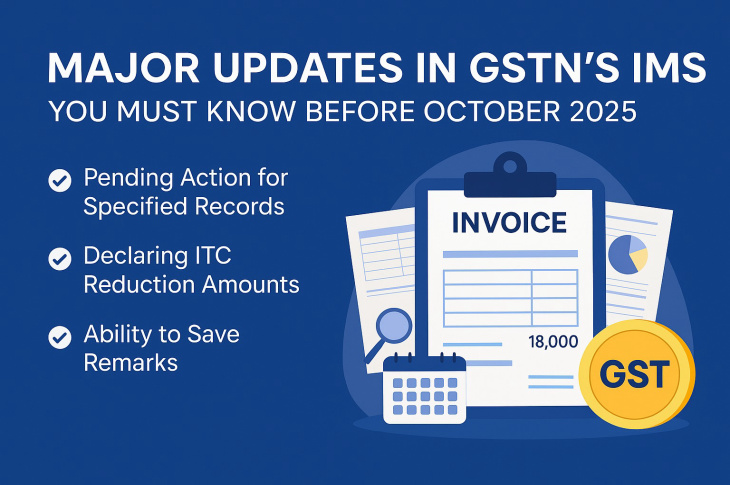Major Updates in GSTN’s IMS You Must Know Before October 2025
Introduction: Why These IMS Updates Matter
The Goods and Services Tax Network (GSTN) is the backbone of India’s GST system. It powers the filing of returns, reconciliation of invoices, and the management of Input Tax Credit (ITC). To make compliance more seamless and taxpayer-friendly, the Invoice Management System (IMS) within the GSTN has undergone significant updates, which will be effective from the October 2025 tax period.
These updates have been introduced after extensive feedback from businesses and tax professionals. They aim to:
-
Simplify GST compliance
-
Reduce confusion in ITC reversals
-
Improve communication between buyers and suppliers
-
Provide flexibility to taxpayers dealing with large transaction volumes
If you are a business owner, CFO, or tax consultant, understanding these changes in advance will help you avoid compliance errors, reduce disputes, and streamline your GST processes.
What Is the Invoice Management System (IMS)?
Before diving into the new updates, let’s understand the basics.
The Invoice Management System (IMS) is an integrated feature in the GST portal that helps:
-
Track invoices, debit notes, and credit notes shared by suppliers
-
Reconcile them with your purchase records
-
Manage ITC claims efficiently
Essentially, IMS acts as a bridge between suppliers and buyers by displaying invoice data in GSTR-2B (for recipients) and ensuring that tax credits are claimed accurately.
With the new changes coming in October 2025, the IMS will become more flexible, transparent, and accurate, reducing compliance burdens.
Key Highlights of the October 2025 IMS Updates
GSTN has focused on three major areas for improvement:
-
Pending Action for Specified Records
(Flexibility to defer action on certain invoices or notes) -
Declaring ITC Reduction Amount
(Precision in ITC reversals—no more guesswork) -
Option to Save Remarks
(Enhanced communication between buyers and suppliers)
Each of these updates has practical implications for businesses. Let’s break them down one by one.
1. Pending Action for Specified Records
What Has Changed
Previously, businesses were required to take immediate action on all records (invoices, debit notes, credit notes, etc.) communicated by suppliers. This caused challenges:
-
Companies with high transaction volumes struggled to review each record within the same tax period.
-
Errors often occurred when premature acceptance or rejection of documents took place.
-
Once action was taken, reversing it later became cumbersome.
To resolve these issues, GSTN now allows taxpayers to keep certain records in a “Pending” status for a limited period.
Who Can Use This Feature
-
Monthly taxpayers: Can defer action for one month
-
Quarterly taxpayers: Can defer action for one quarter
This provides much-needed breathing space to verify documents before finalizing them.
Records Eligible for Pending Action
Taxpayers can keep the following records pending:
-
Credit Notes or Upward Amendments of Credit Notes
-
Downward Amendments of Credit Notes, but only if the original credit note was rejected earlier
-
Downward Amendments of Invoices or Debit Notes, provided that:
-
The original invoice was accepted, and
-
GSTR-3B for that period has already been filed
-
-
Downward Amendments of ECO-Documents (E-Commerce Operator Records), provided that:
-
The original document was accepted, and
-
GSTR-3B has been filed
-
Important Timeline
The due date for keeping records pending is linked to the tax period or date in which the supplier communicated the document.
For example:
-
If your supplier issues a credit note in August 2025 but you file monthly returns, you may choose to keep it pending only until your September 2025 return.
Benefits of the Pending Option
-
Flexibility: Allows businesses to conduct internal verifications before acting.
-
Reduced Errors: Minimizes mistakes caused by rushed accept/reject decisions.
-
Better Reconciliation: Facilitates smoother invoice matching and ITC claims.
2. Declaring ITC Reduction Amount
Earlier Challenges
Earlier, businesses often had to reverse ITC without clear guidance on:
-
How much ITC was originally availed on a particular invoice
-
Whether any ITC was availed at all
This lack of clarity led to:
-
Over-reversals or under-reversals
-
Compliance disputes and audit issues
-
Additional financial burden for businesses
What’s New in October 2025
The IMS now includes a dedicated facility to declare the ITC reduction amount more accurately.
Key clarifications by GSTN:
-
If no ITC was availed on an invoice, no reversal is required.
-
If partial ITC was availed, only that portion needs to be reversed.
This feature introduces data-driven accuracy into ITC management.
How It Works
Businesses can now:
-
Declare the exact amount of ITC availed on each invoice.
-
Reverse ITC fully or partially as per actual availment.
-
Apply the feature even if a reversal was already made earlier.
-
Avoid reversals entirely if ITC was never claimed.
Example for Better Understanding
Let’s consider a real-world example.
-
A supplier issues an invoice of ₹1,00,000 with GST of ₹18,000.
-
The recipient avails only ₹10,000 of ITC (due to partial eligibility).
Earlier:
Reversal often applied to the entire ₹18,000, creating a mismatch.
Now:
Reversal will apply only to the ₹10,000 actually availed.
If no ITC was claimed, no reversal is needed.
Benefits for Businesses
-
Reduced Compliance Burden: Pay only what is necessary.
-
Lower Dispute Risk: Ensures audit-friendly documentation.
-
Enhanced Transparency: Aligns ITC reversals with actual claims.
3. Option to Save Remarks
Why This Matters
Disputes and delays often arise due to lack of clarity between buyers and suppliers regarding why a record was kept pending or rejected.
New Feature in IMS
Taxpayers can now add optional remarks when taking action on records such as invoices, credit notes, or ECO-documents.
How It Works
-
While marking a record as Pending or Rejected, a taxpayer can add a brief remark.
-
This remark will be visible:
-
To the recipient in GSTR-2B
-
To the supplier in their Outward Supplies Dashboard
-
Benefits of Using Remarks
-
Improved Transparency: Both parties can see the reason for action.
-
Fewer Disputes: Suppliers get clear feedback and can act accordingly.
-
Better Documentation: Creates an audit trail for future reference.
Example Scenario
Suppose a business marks a credit note as pending and adds the remark:
“Awaiting supplier confirmation on GST rate change.”
This remark alerts the supplier to review and resolve the issue promptly, reducing delays and confusion.
Applicability and Timeline of New Features
-
The new ITC declaration and reversal feature will be effective from the October 2025 tax period.
-
It will apply only to records filed by suppliers after the rollout date.
-
Older records filed before the rollout will remain unaffected.
Practical Steps Businesses Should Take
1. Review All Invoices and Credit Notes
Ensure that all documents received from suppliers are accurate and complete before acting in IMS.
2. Train Finance and Tax Teams
Teams should be well-versed in:
-
Using the Pending Action feature
-
Entering exact ITC amounts
-
Adding remarks effectively
3. Improve Communication with Suppliers
Leverage the new remarks feature to:
-
Flag discrepancies early
-
Speed up resolution of mismatches
-
Maintain strong vendor relationships
4. Maintain Proper Documentation
Ensure that all pending records, ITC declarations, and remarks are properly archived for:
-
Internal audits
-
Statutory audits
-
Future reference
5. Consult Professionals if Needed
For businesses with large transaction volumes or complex ITC structures, consulting a GST expert can help ensure a smooth transition.
Benefits of the IMS Updates for Businesses
| Benefit Area | Previous Challenges | October 2025 Update Impact |
|---|---|---|
| Compliance Flexibility | Rigid, immediate action required | Option to defer actions for a period |
| ITC Accuracy | Confusing reversals, frequent disputes | Precise declaration and reversal |
| Transparency | Poor communication with suppliers | Optional remarks improve coordination |
| Audit Preparedness | Incomplete records, mismatches | Better documentation and audit trail |
| Cost Efficiency | Risk of over-payment in reversals | Pay only what is actually availed |
Key Takeaways
-
Flexibility in Compliance: Pending action option reduces compliance pressure.
-
Precision in ITC Reversals: Avoids unnecessary payments or disputes.
-
Transparency and Communication: Remarks feature improves coordination between buyers and suppliers.
-
Audit-Friendly System: Reduces risks during GST audits.
Conclusion: Embrace the Change for Better GST Compliance
The October 2025 IMS updates by GSTN mark a significant shift toward simplified, transparent, and accurate GST compliance. By adopting the new features proactively, businesses can:
-
Avoid last-minute compliance challenges
-
Minimize disputes and mismatches
-
Build better relationships with suppliers
-
Enhance overall operational efficiency
As India’s GST ecosystem continues to evolve, staying informed and compliant is key to hassle-free business operations. Start preparing now to leverage the full benefits of the IMS updates.
Official GSTN notification on Changes in Invoice Management System (IMS)
Download NowFrequently asked questions
What is the main purpose of the IMS updates?
What is the main purpose of the IMS updates?
The updates aim to simplify GST compliance, improve ITC accuracy, and enhance communication between buyers and suppliers.
What actions should businesses take before October 2025?
What actions should businesses take before October 2025?
Review records, train teams, use pending and remark features, and maintain strong supplier communication.
Who can use the option to keep records pending?
Who can use the option to keep records pending?
Both monthly and quarterly taxpayers can use it—monthly for one tax period, quarterly for one quarter.
Which types of records can be kept pending?
Which types of records can be kept pending?
Eligible records include credit notes, certain downward amendments, and specified ECO-documents.
How does the new ITC declaration feature help businesses?
How does the new ITC declaration feature help businesses?
It allows businesses to reverse only the actual ITC availed, avoiding unnecessary reversals and disputes.
Can the new ITC feature be applied to older records?
Can the new ITC feature be applied to older records?
No, it applies only to supplier-filed records after the October 2025 rollout.
How does the remarks feature improve compliance?
How does the remarks feature improve compliance?
It enables transparent communication and creates a verifiable audit trail.
Trending
Frequently asked questions
What is the main purpose of the IMS updates?
What is the main purpose of the IMS updates?
The updates aim to simplify GST compliance, improve ITC accuracy, and enhance communication between buyers and suppliers.
What actions should businesses take before October 2025?
What actions should businesses take before October 2025?
Review records, train teams, use pending and remark features, and maintain strong supplier communication.
Who can use the option to keep records pending?
Who can use the option to keep records pending?
Both monthly and quarterly taxpayers can use it—monthly for one tax period, quarterly for one quarter.
Which types of records can be kept pending?
Which types of records can be kept pending?
Eligible records include credit notes, certain downward amendments, and specified ECO-documents.
How does the new ITC declaration feature help businesses?
How does the new ITC declaration feature help businesses?
It allows businesses to reverse only the actual ITC availed, avoiding unnecessary reversals and disputes.
Can the new ITC feature be applied to older records?
Can the new ITC feature be applied to older records?
No, it applies only to supplier-filed records after the October 2025 rollout.
How does the remarks feature improve compliance?
How does the remarks feature improve compliance?
It enables transparent communication and creates a verifiable audit trail.



Ask a Lawyer